 |
 |
 |
| |
New HIV Down in US MSM in 2008-2014, But Up in Hispanics, Younger Men
|
| |
| |
9th IAS Conference on HIV Science (IAS 2017), July 23-26, 2017, Paris
Mark Mascolini
New HIV diagnoses trended downward among US men who have sex with men (MSM) from 2008 through 2014, according to a Centers for Disease Control and Prevention (CDC) analysis [1]. But new diagnoses rose significantly in Hispanic MSM and MSM 13 to 34 years old.
To explore trends in HIV diagnoses among subgroups of US MSM nationally and by state, CDC investigators analyzed National HIV Surveillance System data collected through June 2016 for people at least 13 years old at diagnosis and with infection attributed to sex between men. The analyses considered all MSM and subgroups defined by race/ethnicity and age. To chart changes in diagnosis rates, the CDC team calculated estimated annual percent change (EAPC) for each group.
Among all US MSM, the number of new HIV diagnoses fell from 27,026 in 2008 to 26,637 in 2014, a nonsignificant change (EAPC -0.4, P < 0.1). New diagnoses among Hispanic MSM rose significantly from 6071 in 2008 to 6907 in 2014 (EAPC +2.0, P < 0.0001) while falling significantly in white MSM from 9280 to 7950 (EAPC -2.6, P < 0.0001) and staying flat in black MSM.
From year to year new HIV diagnoses climbed significantly in 13-to-24-year-olds (EAPC +2.6, P < 0.0001) and 25-to-34-year-olds (EAPC +2.8, P < 0.0001). But the rate dropped significantly in 35-to-44-year-olds (EAPC -6.9, P < 0.0001) and 45-to-54-year olds (EAPC -3, P < 0.0001) while not changing significantly in older men.
Among the 50 states and Washington, DC, 12 states had significantly decreasing HIV diagnoses among all MSM and 7 had significantly increasing diagnoses. States with significant declines in new HIV diagnoses among all MSM were spread across the country: California, Colorado, Washington, DC, Delaware, Florida, Georgia, Idaho, Maryland, Missouri, New York, North Carolina, and Washington state. States with significant increases in new diagnoses among all MSM were all in the South or Southwest: Alabama, Arkansas, Arizona, Louisiana, Nevada, South Carolina, and Texas.
For Hispanic MSM 7 states had significant increases in HIV diagnoses and none had significant decreases. For white MSM 1 state had a significant increase and 14 had significant decreases. Numbers of states with significant diagnosis increases and decreases were 16 and 3 for the 13-to-24 group, 18 and 1 for the 25-to-35 group, 0 and 23 for the 35-to-44 group, and 0 and 7 for the 45-to-54 group.
The researchers noted that analyzing HIV diagnosis trends at the national level "obscures important geographic variability." For example, even states with overall drops in diagnoses did not have significant drops among Hispanic MSM. California and Florida has significant declines in HIV diagnoses among all MSM but significant gains among Hispanic MSM.
Reference
1. Oster AM, Tang T, Hall HI. Trends in HIV infection diagnoses among men who have sex with men, overall and by state, United States, 2008-2014. 9th IAS Conference on HIV Science (IAS 2017), July 23-26, 2017, Paris. Abstract TUPEC0790.
------------------------------
Trends in HIV infection diagnoses among men who have sex with men, overall and by state, United States, 2008-2014
Alexandra M. Oster, MD; Tian Tang, MS; H. Irene Hall, PhD
Division of HIV/AIDS Prevention, Centers for Disease Control and Prevention, Atlanta, Georgia, United States

Trends in HIV infection diagnoses among men who have sex with men, overall and by state, United States, 2008-2014
Alexandra M. Oster, MD; Tian Tang, MS; H. Irene Hall, PhD
Division of HIV/AIDS Prevention, Centers for Disease Control and Prevention, Atlanta, Georgia, United States
Table 3. Estimated annual percent change (EAPC) in HIV diagnoses among MSM during 2008-2014 in each state and the District of Columbia, overall and by race/ethnicity and age group.
State of residence at HIV diagnosis

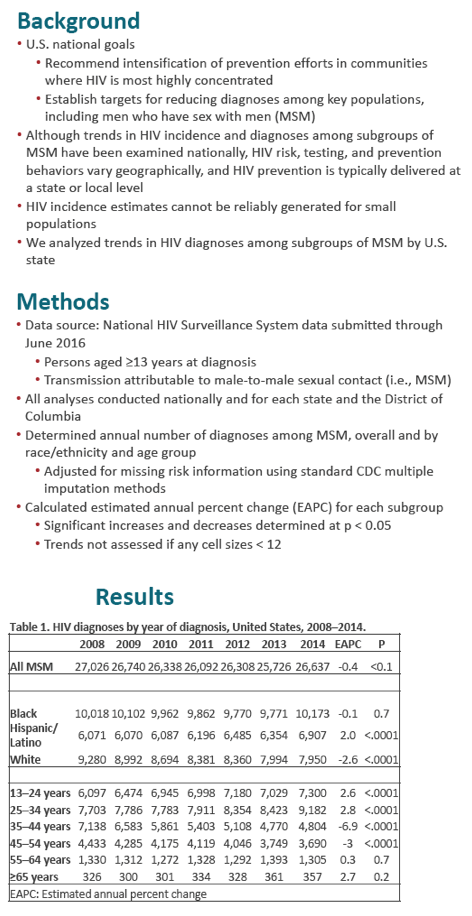
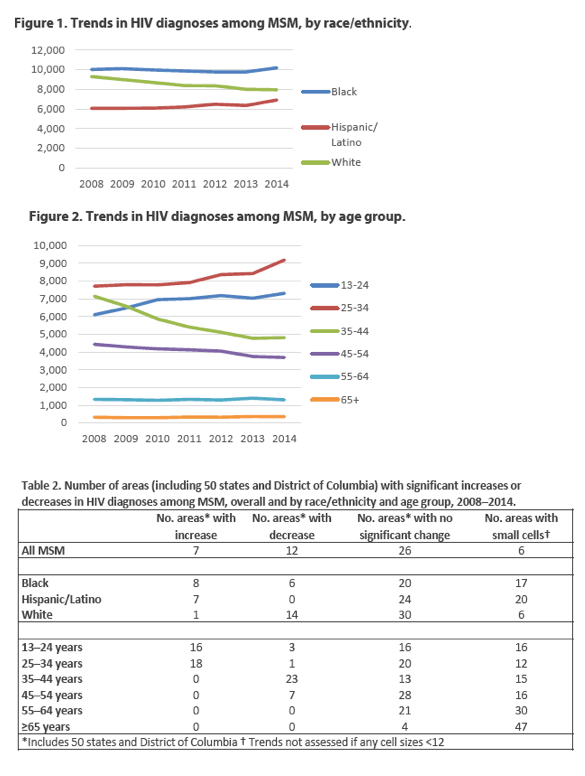
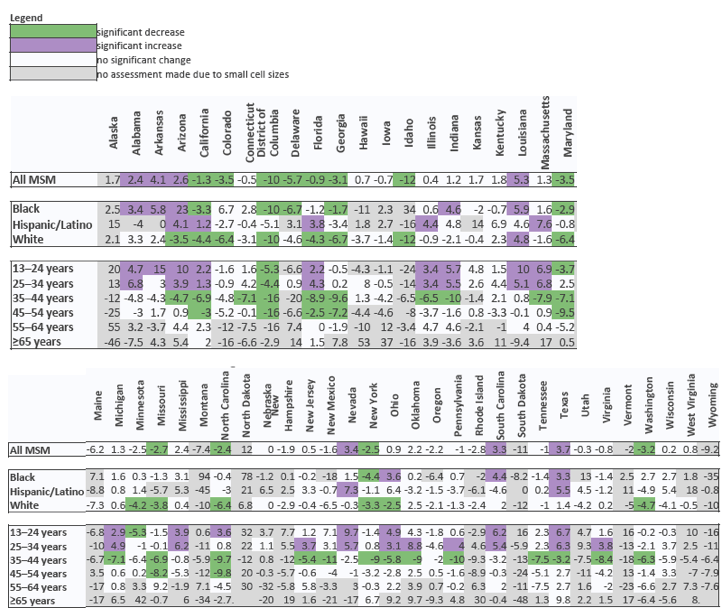

--------------------------------
Analysis of U.S. HIV sequence data indicates that recent and rapid HIV transmission is focused among young Hispanic/Latino men who have sex with men
Alexandra M. Oster, MD;1Anne Marie France,1Nivedha Panneer,1Joel O. Wertheim, 1,2M. Cheryl BañezOcfemia,1Sharoda Dasgupta,1Angela L. Hernandez1
1 Division of HIV/AIDS Prevention, Centers for Disease Control and Prevention, Atlanta, Georgia, United States and 2 University of California, San Diego
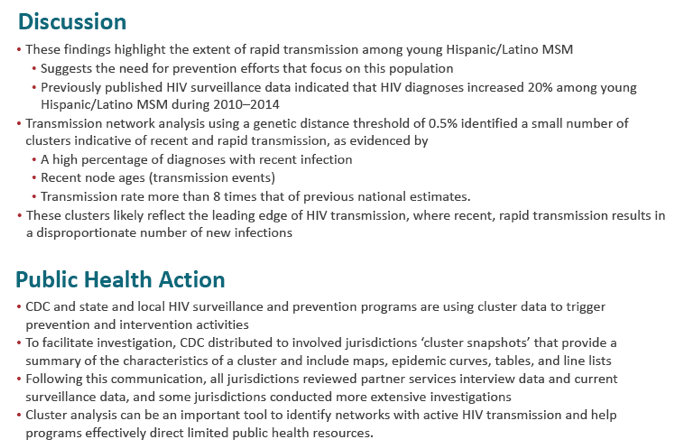
abstract
Background: Although the estimated rate of HIV transmission in the United States is approximately 4 transmission events per 100 person-years, the rate of transmission in some risk networks is likely much higher. Identifying these networks can provide critical data for focusing efforts on populations in need of the most intensive prevention interventions. To describe the leading edge of HIV transmission, we identified molecular clusters with recent and rapid growth, determined the transmission rate for these clusters, and described the persons involved in rapid transmission.
Methods: We analyzed baseline partial HIV-1 polymerase sequences reported to the National HIV Surveillance System through December 2015 by 27 participating jurisdictions for persons with HIV diagnosed during 2013-2015. We calculated genetic distance for each pair of sequences. Using a pairwise threshold of 0.005 substitutions/site, we inferred clusters and identified rapidly growing clusters (those with ≥5 diagnoses during 2015). We used node ages determined through molecular clock phylogenetic analysis to calculate HIV transmission rates for these rapidly growing clusters and compared persons in these clusters to other persons with sequences included in the analysis, accounting for correlation between cases in the same cluster.
Results: Sequences were analyzed for 30,323 persons; 13 rapidly growing clusters were identified. These clusters had a transmission rate of 34/100 person-years. Compared with the 30,127 persons not in these clusters, the 196 persons in these 13 clusters were disproportionately men who have sex with men (MSM) (94% vs. 62%, P< 0.0001), aged < 30 years (68% vs. 41%, P< 0.0001), Hispanic/Latino (49% vs. 28%, P< 0.0001), and, specifically, young Hispanic/Latino MSM (32% vs. 9%, P< 0.0001). The clusters included high levels of transmitted drug resistance (43% vs. 20%, p=0.0006).
Conclusions: This approach identified a small number of clusters with a transmission rate more than 8 times that of previous national estimates. These findings highlight the extent of rapid transmission among young Hispanic/Latino MSM, suggesting the need for prevention efforts that focus on this population. Identifying clusters of active transmission can help programs effectively direct limited public health resources.
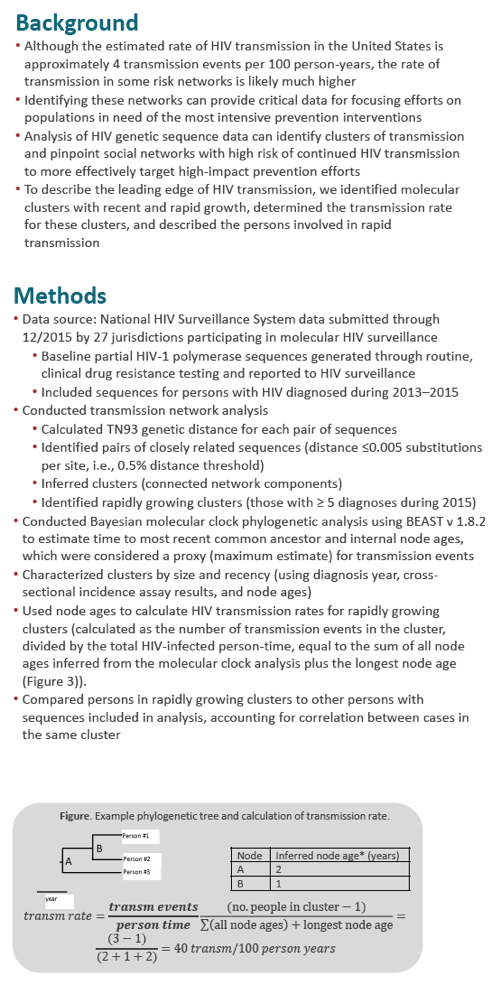
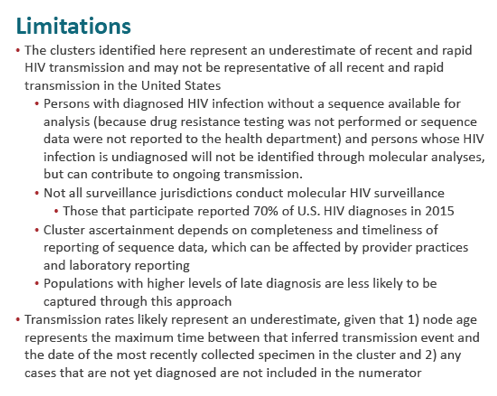
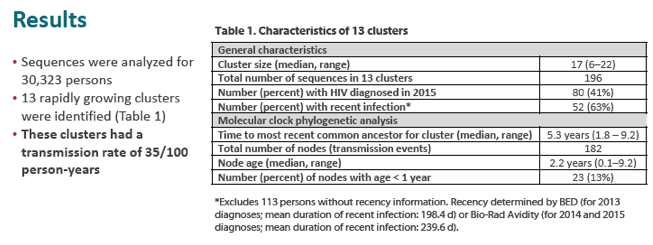
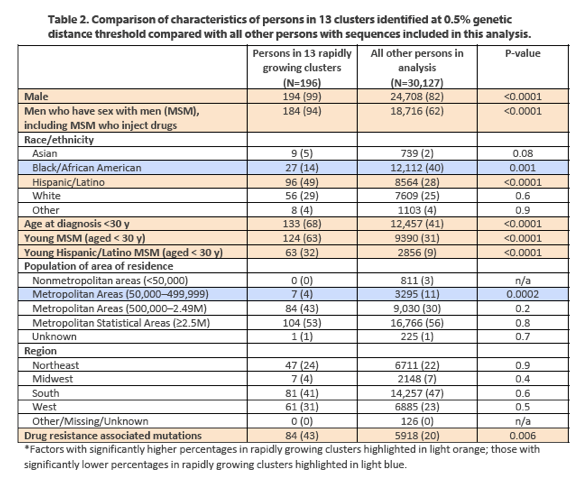
|
| |
|
 |
 |
|
|